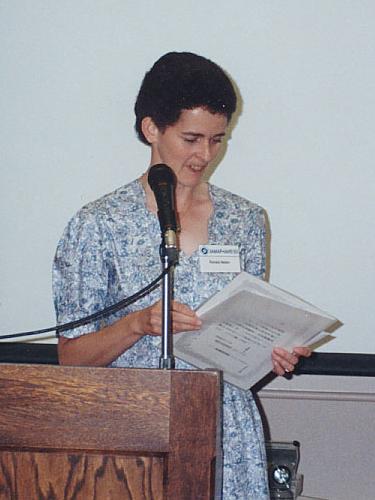Tison Award 1993

Dr P. Naden in Yokohama
1993 Tison Award presented to Dr Pamela S. Naden
The award was given for her paper titled Spatial variability in flood estimation for large catchments; the exploitation of channel network structure, published in Hydrological Sciences Journal 37(1), February 1992. The Award was presented during the IAHS Plenary on 22 July 1993 at Yokohama.
The Award Committee stated:
Dr Naden presented an original methodology for synthesis of the catchment response. Her method belongs to the category of linear unit hydrograph models in a physically-based framework, i.e. with parameters which can be derived from data or catchment characteristics. Although the established UK Flood Studies Report recommends that such a philosophy of approach is applicable for catchments with areas under 500 km2, the method is extended in the presented paper to a much larger catchment (area of 7000 km2). While three elements ? the input, the catchment response, and the output ? are used in the classical unit hydrograph approach, there are four components distinguished in the reviewed paper. The catchment response function consists of the hillslope response and of the network response. The latter component is a two?parameter physically based linear routing scheme (diffusion analogy). The novelty of the approach is the way of incorporating spatial variability in the flood estimation procedure. This has been accomplished with the help of a function describing the spatial distribution of channels within the catchment. It is determined via the relation between the number of channels and the distance to the outlet (concept analogous to that of the time?area diagram, which can be approximated from maps or digital data sources) and the routing function (distance travelled versus time). Spatial variability in the rainfall input is expressed in terms of the proportion of the total catchment areal rainfall received.
The results mimic the behaviour of the observed flows with accuracy which may be sufficient in several applications. As noted by the author, the success of this simple approach for a large catchment can be explained to some extent by the fact that slow hillslope response plays a dominant role thus masking any impact of spatial variation in rainfall. However, further work towards extension of the domain of spatial applicability of the approach towards larger catchments would seem promising.
